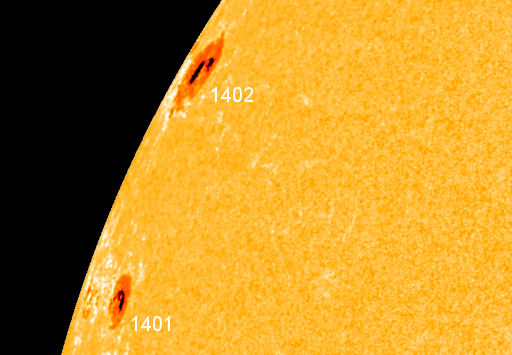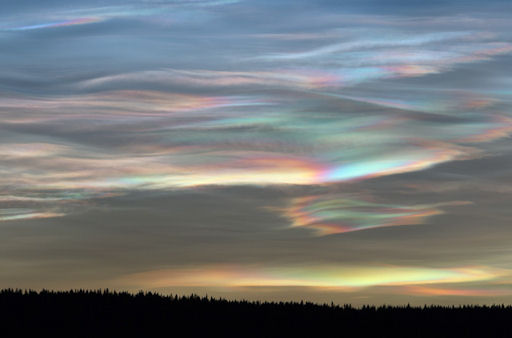PHOBOS-GRUNT RE-ENTRY TODAY: Russia's malfunctioning Mars probe, Phobos-Grunt, will re-enter the atmosphere today, creating a brilliant fireball over a still-unknown part of Earth. Best estimates of the re-entry time range from 1700 UT to 2200 UT on Jan. 15th. The Aerospace Corporation has published some possible ground tracks.
ACTIVE SUNSPOTS: Crackling with C-class solar flares, a pair of active sunspots is emerging over the sun's northeastern limb. NASA's Solar Dynamics Observatory photographed the pair during the early hours of Jan. 15th:
These sunspots have the potential for strong eruptions. Sunspot 1401 produced an M1-flare on Jan. 14th. Two days earlier, while it was still on the farside of the sun, sunspot 1402 produced a partially-eclipsed flare of uncertain magnitude that created waves of ionization in the atmosphere over Europe.
NOAA forecasters estimate a 30% chance of more M-flares during the next 24 hours. Solar flare alerts: text, voice.
POLAR STRATOSPHERIC CLOUDS: An apparition of polar stratospheric clouds is underway around the Arctic Circle. "It is almost as good as the aurora borealis," says Göran Strand, who took this picture last night from Östersund, Sweden:
Eric Schandall of Oslo, Norway, adds this report: "We have seen them for three evenings over Oslo, with the ones on Jan. 13th being the most dramatic and beautiful so far."
Also known as "nacreous" or "mother of pearl" clouds, these icy clouds form in the lower stratosphere when temperatures drop to around minus 85ºC. Sunlight shining through tiny ice particles ~10µm across produce the characteristic bright iridescent colors by diffraction and interference.
"Nacreous clouds far outshine and have much more vivid colours than ordinary iridescent clouds, which are very much poor relations and seen frequently all over the world," writes atmospheric optics expert Les Cowley. "Once seen they are never forgotten."

![]()
Solar wind
speed: 348.5 km/sec
density: 4.1 protons/cm3
explanation | more data
Updated: Today at 1316 UT
![]()
X-ray Solar Flares
6-hr max: C1 1101 UT Jan15
24-hr: C2 0210 UT Jan15
explanation | more data
Updated: Today at: 1300 UT
![]()
![]()
![]()
Daily Sun: 14 Jan 12
![]()
![]()
All of these sunspots are quiet. The chance of flares today is low. Credit: SDO/HMI
![]()
![]()
![]()
Sunspot number: 145
What is the sunspot number?
Updated 13 Jan 2012
Spotless Days
Current Stretch: 0 days
2012 total: 0 days (0%)
2011 total: 2 days (<1%)
2010 total: 51 days (14%)
2009 total: 260 days (71%)
Since 2004: 821 days
Typical Solar Min: 486 days
Updated 13 Jan 2012
The Radio Sun
10.7 cm flux: 124 sfu
explanation | more data
Updated 13 Jan 2012
![]()
![]()
![]()
Current Auroral Oval:
![]()
Switch to: Europe, USA, New Zealand, Antarctica
Credit: NOAA/POES
![]()
![]()
![]()
Planetary K-index
Now: Kp= 0 quiet
24-hr max: Kp= 1 quiet
explanation | more data
![]()
Interplanetary Mag. Field
Btotal: 4.0 nT
Bz: 1.5 nT north
explanation | more data
Updated: Today at 1317 UT
![]()
![]()
![]()
Coronal Holes: 14 Jan 12
![]()
![]()
A solar wind stream flowing from the indicated coronal hole should reach Earth on Jan. 16-17. Credit: SDO/AIA.






